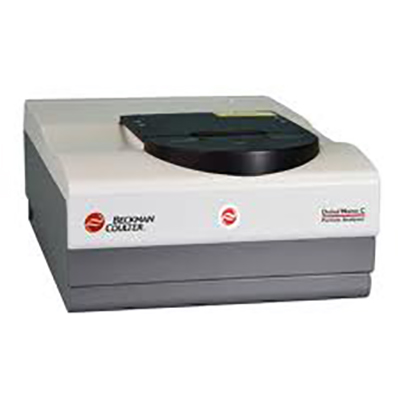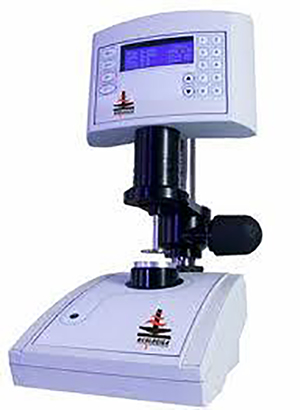Physics
Characterization Techniques
Bruker D8 Advance X-ray Diffractomer (NSF Funded)
The state of the art Bruker D8 Advance XRD system is equipped with scintillation detector and fast Vantec-1 detector. The system also has chi, phi, theta, and x-y-z motion. A high temperature (RT-1400 oC) stage is easily mounted on the stage. Powerful software such as LEPTOS and TOPAPA are used for the data analysis and modeling. The system is regularly used for performing powder diffraction and thin film reflectrometry.

Atomic Force Microscope (AFM) (NSF Funded)
The Atomic Force Microscope DI 3000 is housed at the Integrated Microscopy Center. The microscope is equipped with phase imagining, magnetic imaging, nanoindentation, surface potential, liquid cell, and inverted microscope.

Particle Size and Zeta Potential Analyzer
Delsa NanoS
The DelsaNano S measures particles as small as 6 Angstrom and as large as 7 micron with molecular weight as small as 267 Dalton in a concentration range from 10ppm to 40%* (w/v). It uses precision optics to avoid light intensity and coherence loss due to fiber optics collection. The utilization of both log-scale and linear-scale correlators makes broadest size range measurement possible. The system is also equipped with cell to measure zeta potential of solid flat surfaces.

Magnetic Characterization
Vibrating Sample Magnetometer
The vibrating sample magnetometer (VSM) is has air cooled 1.1T magnet. The system is capable of performing RT hysteresis measurement.
Mossbauer Spectrometer (NSF-Funded):
Mossbauer spectroscopy (Seeco, Inc) is a resonance spectroscopy which uses Co gamma source to probe iron atom and its coordination. This spectrometer is equipped with LT (77K) and HT (500 C) attachments. The hyperfine parameters such as hyperfine field, isomer shift and quadrupole shift provide wealth of information on the nature of iron atom in the metal, oxides, and biological compounds.
AC Resistance/Inductance Bridge:
The low temperature AC bridge measures resistance of materials as a function of temperature (10-400 K) and external magnetic field (500 Oe). The magnetic field is provided by Helmholtz coils. The resistance is measured using four-probe method using Linear Research bridge. The bridge is sensitive up to 1 micro Ohm reading. The sample stage is designed to study giant-magneto resistance materials in the presence of in-plane magnetic field. The entire setup is controlled by LabView. The bridge is also used to study susceptibility and magnetization of magnetic materials using inductance method.

Temperature Dependent High Resistance
Resistivity in the range of giga Ohms of materials is measured using SVS Lab resistivity bridge (TPR-EXP) in the temperature range of 295-500 K.
Magneto-resistance Measurement
Magneto-resistance measurement device is a home build device. The device is capable of measuring magneto-resistance as a function of magnetic field (maximum 2000 Oe) and rotational angle of the sample. The resistance is measured using Keithly 330 source meter in 4-point probe geometry and van der paw geometry. The system automated using Labview program.
Dielectric Measurement
Frequency Dependent
Dielectric property of materials is characterized using Agilent Fieldfox 14 GHz vector network analyzer using Dielectric Assessment Kit (DAK) probe (SPEAG, Switzerland). The dielectric probes is designed for fast, precise, non-destructive and easy to use measurements of liquids, solids and semi-solids in the 200 MHz to 20 GHz frequency range. The DAK software allows to view choice of the complex permittivity parameters (ε', ε", σ, tanδ) in a variety of data formats (linear and logarithmic charts, Smith chart, Cole-Cole plot and tabular).
Temperature Dependent
Temperature dependent dielectric property of materials is characterized using SVS Lab. dielectric analyzer (DEC-01) in the temperature range 295K to 500 K.
Precission Multiferroic System
Radiant Technology RT600, Precision Multiferroic test system is designed specifically to characterize the electrical properties of non-linear materials. The Vision Software allows the user to construct complex or simple programs with any number of tests to characterize all aspects of the sample in one execution while keeping track of the measurement results and the history of the sample being tested. A polarization hysteresis measurement applies an electric field to the sample while measuring the change in the sample polarization. Electric Field (E) and Polarization (D) are two of the six thermodynamic properties of materials. The other four are Stress (T), Strain (S), Temperature (Q) and Entropy (s). Of the six, all can be stimulated and/or measured directly except for Entropy (s).
Thermal Characterization
Differential Scanning Calorimeter
Dupont DSC has a wide temperature range of operation from liquid nitrogen temperature to 600 degree C. Thus, the equipment is used for thermal characterization of wide range of materials from polymers, oxides, to metallic system. The DSC is computer controlled and has data analysis software.

Thermogravemetric Analyzer
Dupont TGA has a wide temperature range of operation from RT to 1000 degree C. The TGA is computer controlled and has data analysis software.

Optical Characterization
UV-Vis-IR Spectrophotometer
The spectrophotometer (Ocean Optics) is a table top device with a UV-Vis-IR source, optical fibers, gas cell, and CCD detector. The system is used to study the optical properties of colloids and nanoparticles.
EnWave EZRaman-XB Spectrometer
Fully integrated portable Raman system equipped with 785nm frequency stabilized 250 mW laser and with a spectral range of 250-2350 cm-1.

FTIR
Thermo Scientific IR 100 has a spectral range of 7800 to 375 cm-1 with resolution down to 4cm-1. The Nicolet IR100 FT-IR has inbuilt software and a sample compartment mount for standard transmission accessories such as liquid cells, KBr pellets, and ATR assembly. ATR assembly is equipped with ZnSe crystal.
Other
Merlin High Performance Viscometer
This temperature controlled (5-85 oC) The MERLIN viscometer is well suited for investigating the mixing, stirring, and pumping behavior of coatings, emulsions, and dispersions, as well as for performing conventional flow and viscosity profile experiments.The innovative design incorporates a Peltier temperature control system that allows isothermal, step, and/or ramp temperature profiles.

Autosorb-I
Quantchrome Autosorb-I provides automated analysis of pore size and surface area measurement of variety of inroganic and organic materials, using variety of adsorbates.

